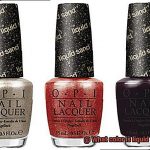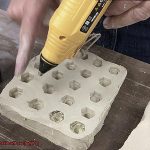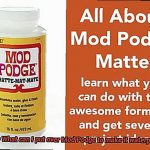The superhero of adhesives, saving broken items and completing DIY projects with its unmatched strength. But hold on a second. Before you grab that trusty bottle, let’s take a closer look at the not-so-super side effects lurking beneath its shiny surface.
Sure, super glue has its fair share of benefits, but it’s crucial to understand its limitations and potential negatives. From skin irritation to inflexibility and rapid bonding, we’re about to dive into the dark underbelly of this beloved adhesive.
What are the negatives of super glue?
Contents
- 1 What are the negatives of super glue?
- 2 Super Glue Can Be Difficult to Remove
- 3 Fumes From Super Glue Can be Irritating
- 4 Super Glue is Not Flexible Once Dried
- 5 Not Suitable for Certain Materials
- 6 Accidental Contact Can Cause Skin Irritation
- 7 Difficult to Make Adjustments After Bonding
- 8 Limited Shelf Life
- 9 May Not Bond Well with Some Plastics or Metals
- 10 Toxic if Ingested or Inhaled
- 11 Cannot Be Used in High-Temperature Environments
- 12 Conclusion
Skin Irritation:
Here’s the sticky truth: super glue can be a real pain in the skin. Its powerful bonding properties mean that once it touches your precious epidermis, discomfort and rashes may follow suit. So, handle with care and avoid direct contact unless you want an itchy situation on your hands.
Lack of Flexibility:
Picture this: you’ve glued two materials together with super glue, only to realize they need a little wiggle room. Well, tough luck. Once applied, super glue hardens into an inflexible bond that won’t budge for anything or anyone. This lack of flexibility can lead to cracks and compromises in durability—definitely not ideal for those bendy projects.
Rapid Bonding:
Time is money, they say. But when it comes to super glue’s speedy bonding process, time can also be trouble. Once that adhesive hits the surface, it dries faster than you can say “oops.” Repositioning or making adjustments becomes mission impossible—a curse for intricate projects or those prone to misalignments. Prepare yourself for subpar results or wasted materials if you’re not careful.
Lack of Strength on Certain Materials:
Super glue may be strong like bull on most surfaces, but there are some materials that just won’t play nice. Think slick plastics or shiny metals—they’re like the cool kids who won’t let the glue form strong bonds. So, if you’re working with these tricky textures, don’t expect super glue to work its magic.
Toxicity:
Last but not least, we have a toxic secret to spill. Super glue often contains chemicals like cyanoacrylate that can emit harmful fumes when inhaled. Now, take a deep breath (but not too deep) because this risk is relatively low in well-ventilated areas. However
Super Glue Can Be Difficult to Remove
Super glue, also known as cyanoacrylate adhesive, is renowned for its rapid and robust bonding properties. However, these very characteristics that make it a popular choice for various materials also contribute to the challenge of removing it. In this blog post, we will delve into the reasons why super glue can be so difficult to remove, the potential risks involved, and some effective techniques for safe removal.
Quick Drying and Strong Bond:
Super glue sets in a matter of seconds, creating an incredibly strong bond. Its rapid drying time makes removal a daunting task once it adheres to a surface. The strength of this bond is so formidable that attempting to forcibly remove the glue may result in irreparable damage to the material.
Surface-Specific Techniques:
Different surfaces necessitate distinct techniques for removing super glue effectively. For example, acetone or nail polish remover may be employed on glass surfaces, while fabric surfaces may benefit from soaking in warm, soapy water and gentle scrubbing. Understanding the appropriate technique for each specific surface is essential to avoid causing further harm or damage.
Potential Damage:
Forceful scraping or using sharp objects to remove super glue can lead to unsightly scratches or marks on delicate materials like wood or plastic. To prevent additional damage, it is crucial to exercise caution and utilize appropriate tools during the removal process.
Residue Remnants:
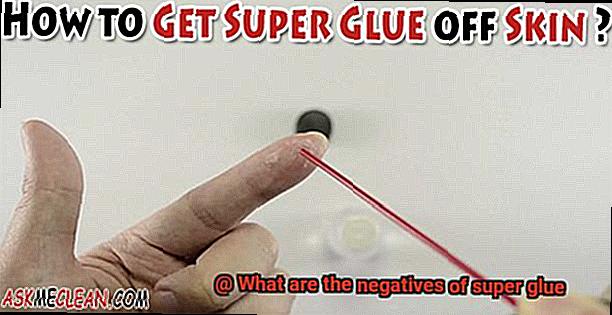
Even after successfully removing the majority of the super glue, sticky residue often persists stubbornly. Eliminating this residue completely can be a tedious and time-consuming task, requiring additional cleaning or scraping.
Spills and Accidental Bonding:
Accidental spills or bonding of fingers or objects can create particularly challenging situations. Acting swiftly and following specific instructions for safe removal without causing harm is imperative in these instances.
Specialized Products:
Thankfully, the market offers specialized products specifically designed for super glue removal. These products typically contain solvents that weaken the bond, making it easier to remove the glue without causing damage.
Fumes From Super Glue Can be Irritating
Super glue, also known as cyanoacrylate adhesive, is a popular choice for bonding materials due to its quick-drying and strong bonding properties. However, it’s important to be aware that the fumes emitted during the curing process can be irritating to the respiratory system, eyes, and skin. In this article, we will explore the potential irritation caused by super glue fumes and discuss the precautions you should take when using it.
Understanding the Irritation:
Cyanoacrylate Vapors: When super glue comes into contact with moisture in the air, it releases fumes called cyanoacrylate vapors. These vapors can irritate your respiratory system, causing symptoms such as coughing, a sore throat, and watery eyes. They can also lead to skin irritation if they come into direct contact with your skin.
Precautions to Minimize Exposure:
To protect yourself from these irritating fumes, here are some precautions you should take:
- Work in a Well-Ventilated Area: It is essential to use super glue in a well-ventilated area to minimize exposure to the fumes. Make sure there is proper airflow by opening windows or using fans. This will help disperse the fumes and reduce their concentration in the air.
- Wear Protective Equipment: To prevent direct contact with the fumes, it’s important to wear protective equipment such as gloves, safety goggles, and a mask. These items act as a physical barrier and provide an extra layer of protection.
- Consider Sensitivity: Individuals with respiratory conditions such as asthma or allergies may be more sensitive to super glue fumes. If you fall into this category, it’s crucial to take extra precautions and consider using alternative adhesives if necessary.
Dealing with Allergic Reactions:
It’s worth noting that some individuals may develop an allergic reaction to super glue itself, rather than just its fumes. If you notice any of the following symptoms after using super glue, it may indicate an allergic reaction:
- Redness, swelling, or itching at the site of contact with super glue
- A rash or hives
If any of these symptoms occur, it’s important to discontinue use of the product and seek medical advice. A healthcare professional can provide appropriate treatment and guidance.
Super Glue is Not Flexible Once Dried
Super glue, also known as cyanoacrylate adhesive, is a go-to adhesive for its quick-drying and strong bonding properties. However, its lack of flexibility once dried can be a real headache in certain applications.
When super glue dries, it becomes hard and rigid, making it prone to cracking or breaking when subjected to bending or stretching. This rigidity makes it unsuitable for projects that involve materials like fabrics, rubber, or certain plastics that require some wiggle room. Imagine trying to repair a torn fabric or join two rubber surfaces together with a material that can’t flex—it’s like trying to fit a square peg into a round hole.
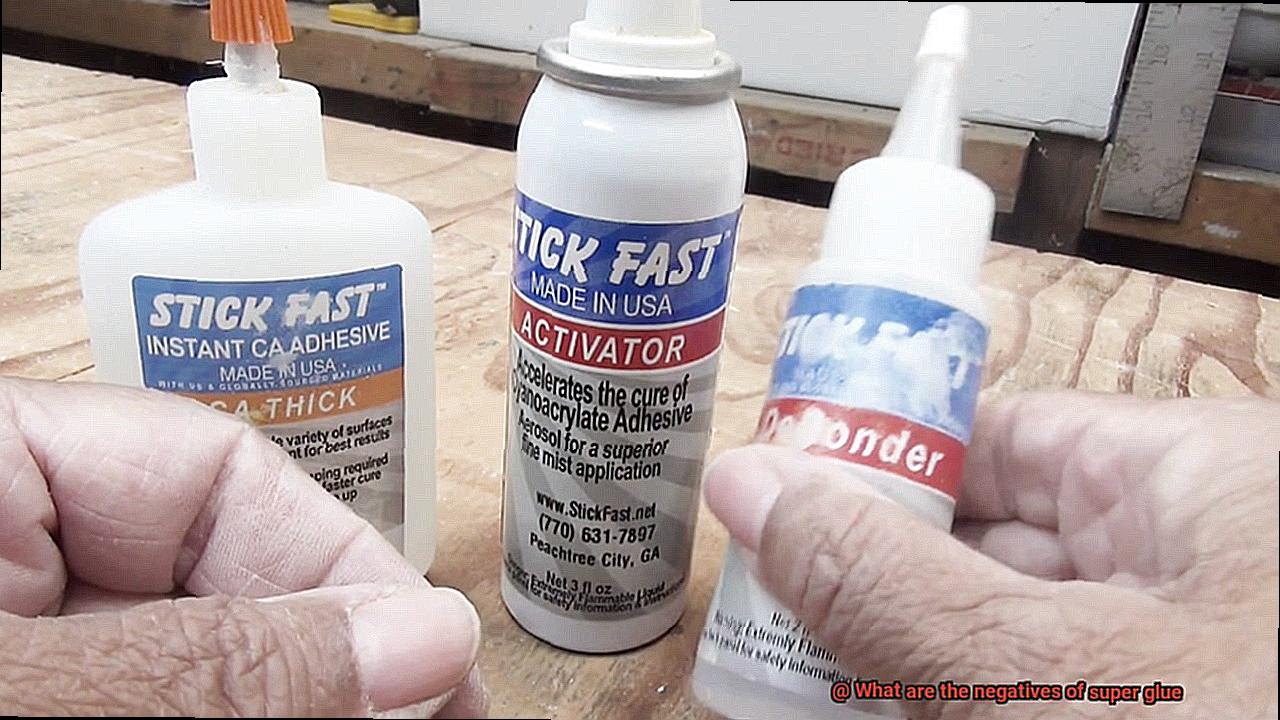
But the lack of flexibility doesn’t stop there. If you’re working with objects that have uneven or curved surfaces, super glue may struggle to adhere properly. The rigid nature of the dried adhesive prevents it from conforming to these surfaces, resulting in weak or ineffective bonds that won’t stand the test of time.
Extreme temperatures can also pose a problem for super glue. While it is generally resistant to heat and cold, the rigidity of the dried adhesive can make it brittle and weaken its bonding strength under extreme temperature conditions. So if you’re planning to use super glue in a high-temperature environment or in freezing conditions, think again.
However, fear not. Some manufacturers have come up with flexible versions of super glue that address these limitations. These magical formulations retain their bonding strength while allowing for some level of flexibility. They’re like the superheroes of the adhesive world.
In conclusion, while super glue is undoubtedly a powerful adhesive, its lack of flexibility once dried can be a real bummer in certain projects. It may not provide durable bonds for materials that need some give or for objects with tricky surfaces. Thankfully, flexible versions are here to save the day and provide more suitable bonding options.
Not Suitable for Certain Materials
Super glue, also known as cyanoacrylate adhesive, is a powerful tool in the world of adhesives. Its fast-drying and strong bonding properties have made it a popular choice for various projects. However, it is important to understand that super glue is not a one-size-fits-all solution. In this blog post, we will explore why super glue is not suitable for certain materials and discuss alternative options for those tricky projects.
The Challenge of Porous Materials:
Super glue’s quick-drying nature can be a disadvantage when it comes to porous materials like wood, fabric, or paper. These materials have tiny holes or spaces that allow air or liquid to pass through. As super glue dries rapidly upon exposure to air, it may not have enough time to penetrate the porous surface and form a strong bond. This can result in a weak bond or no bond at all.
Glass Surfaces and their Slippery Nature:
Glass surfaces present another challenge for super glue. Glass is smooth and non-porous, making it difficult for the adhesive to adhere effectively. Additionally, the transparency of glass can make it challenging to apply the glue evenly, resulting in an uneven bond that may compromise the project’s integrity.
Certain Plastics and their Interference:
Super glue may not be suitable for bonding certain types of plastics. Some plastics contain chemicals or additives that can interfere with the bonding process. Moreover, plastic surfaces often have low surface energy, making it difficult for the adhesive to form a strong bond.
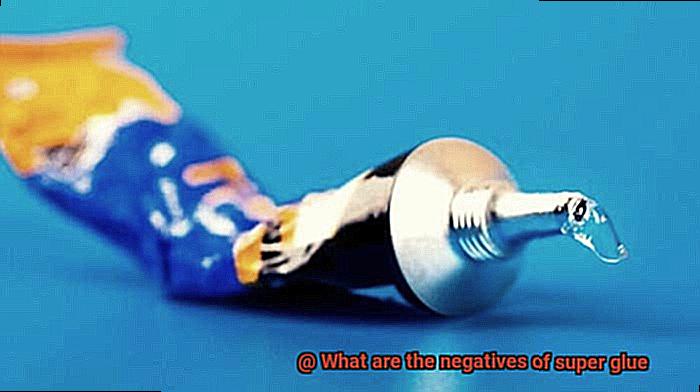
Flexible Materials and Stressful Situations:
Flexibility is not super glue’s forte. It becomes brittle over time, especially when subjected to temperature changes or excessive pressure. This limitation makes it unsuitable for use on flexible materials or items that need to withstand significant stress or movement. The adhesive’s rigidity can lead to weak bonds or breakage, causing the glued items to separate.
Compatibility with Metals:
When using super glue on metal surfaces, it is crucial to consider the type of metal involved. While super glue can work well on certain metals like aluminum or stainless steel, it may not be as effective on other metals like copper or brass. Factors such as surface roughness, cleanliness, and chemical composition can affect the adhesive’s compatibility with different metals.
Human Skin and Safety Concerns:
Lastly, it is essential to exercise caution when using super glue on human skin. The adhesive bonds quickly, making accidental contact potentially harmful or uncomfortable. If accidental contact occurs, seeking medical advice is recommended rather than attempting to forcefully remove the adhesive.

Accidental Contact Can Cause Skin Irritation
Prepare to uncover the dark side of one of our beloved adhesives – super glue. While it may be a superhero in the world of bonding materials, it can wreak havoc on our delicate skin. Join us as we dive into why accidental contact with super glue can cause skin irritation and explore the precautions you can take to avoid this sticky situation.
The Bonding Beast:
Super glue, or cyanoacrylate adhesive, possesses remarkable strength and dries in a flash, making it a go-to choice for impromptu repairs or crafting projects. However, this very strength turns into a villain when it encounters our skin.
The Irritation Invasion:
When super glue makes contact with the skin, it forms an instant bond, creating a tight seal that leads to discomfort and irritation. As the glue hardens, it creates a barrier on the skin’s surface, resulting in redness, swelling, and pain in the affected area. In severe cases, the adhesive’s chemical properties can even cause blisters or burns.
Factors at Play:
The severity of skin irritation depends on various factors. The duration of contact, the amount of glue applied, and individual sensitivity to the adhesive all contribute to determining the extent of the reaction. Those with sensitive or damaged skin are particularly susceptible to experiencing adverse reactions when exposed to super glue.
The Great Escape:
Removing super glue from the skin requires caution and proper technique. Pulling or tugging at the bonded area can damage the skin and potentially tear it. Instead, soaking the affected area in warm soapy water or using an acetone-based nail polish remover gradually dissolves the adhesive without harming the skin.
Prevention is Better than Reaction:
To avoid this sticky situation altogether, preventive measures are crucial. Wearing protective gloves and using tools like tweezers or applicators can minimize direct contact with the adhesive. Working in a well-ventilated area also reduces exposure to fumes that may irritate the respiratory system.
Difficult to Make Adjustments After Bonding
Super glue, the magical adhesive superhero we all love, has a dark side – it can be incredibly difficult to make adjustments after bonding. This is due to its quick-setting nature and the strength of its bond.
Firstly, super glue sets at lightning speed, leaving little time for repositioning or realigning materials. For delicate or intricate items that require precise positioning, this can be a nightmare. There’s hardly any room for error.
Secondly, once super glue dries and sets, it forms an incredibly strong bond. It’s like a molecular love connection between the surfaces you’re gluing. While this is great for durability, it becomes a nightmare when you need to separate the bonded materials. Trying to force them apart can lead to broken pieces or damaged surfaces. Nobody wants that.
Even if you manage to make adjustments after bonding, they may not be as secure or reliable as the original bond. Super glue is designed to fill in gaps and irregularities on surfaces, creating a tight seal. Any subsequent adjustments may disrupt this mechanism and weaken the overall connection. Talk about frustration.
But fear not. There are specialized super glues called “gel” or “removable” super glues that offer more flexibility and allow for minor adjustments even after bonding. However, they still have limitations and may not be suitable for all applications.
To overcome the difficulty of making adjustments after bonding with super glue, careful planning and preparation are crucial. Double-check alignments and ensure everything is in place before applying the adhesive. Use clamps or other securing mechanisms to hold things in position while the glue sets. This minimizes the need for adjustments later on.
Limited Shelf Life
Super glue, also known as cyanoacrylate adhesive, is a remarkable adhesive that can bond almost anything together in an instant. However, there’s a catch – limited shelf life. In this comprehensive guide, we’ll delve into the importance of paying attention to the expiration date and proper storage techniques for super glue.
Why does the expiration date matter?
Chemical composition:
Super glue contains cyanoacrylate monomers that react with moisture in the air to create an indestructible bond. However, over time, exposure to moisture can cause the glue to harden and become ineffective. This means that expired super glue won’t hold up to its promises of strength and durability.
Ineffectiveness:
Using expired or compromised super glue can result in a nightmare of thick, clumpy, or solidified glue that refuses to cooperate. Imagine trying to fix something only to be met with wasted product and frustration. It’s a waste of time, effort, and money.
Weak bonds:
Expired super glue may fail to provide the necessary strength and reliability for various applications. Whether it’s repairing broken items or securing loose parts, weak bonds can compromise safety and longevity. Don’t risk it.
Proper storage tips:
Tightly seal the bottle:
After each use, make sure to tightly seal the bottle to prevent moisture from entering and affecting the glue. A little effort goes a long way in preserving the adhesive’s power.
Store in a cool, dry place:
Heat and humidity are enemies of super glue. Find a cool, dry place like a cupboard or drawer away from direct sunlight or sources of heat. Protect your investment.
Refrigeration:
Storing super glue in a refrigerator can extend its shelf life by slowing down the reaction with moisture. However, remember to allow the glue to reach room temperature before using it to avoid condensation on the adhesive surface. A small inconvenience for long-lasting performance.
The consequences of using expired super glue:
Weakened bonds:
Expired super glue can result in weak bonds that are prone to failure. Don’t put yourself or your projects at risk.
Potential damage:
In critical applications like medical procedures or aerospace manufacturing, using expired super glue can have severe consequences. Compromised strength and reliability may lead to catastrophic results. Don’t take chances.
May Not Bond Well with Some Plastics or Metals
Super glue, also known as cyanoacrylate adhesive, is renowned for its remarkable bonding capabilities. However, it encounters challenges when attempting to adhere to specific plastics or metals. In this captivating exploration, we will delve into the reasons behind this limitation and provide invaluable insights on how to overcome them.
Low Surface Energy Plastics:
Plastics like polyethylene and polypropylene possess a characteristic known as low surface energy. This attribute renders their surfaces non-porous and smooth, making it arduous for super glue to establish a strong bond. These plastics are ubiquitous in everyday items such as plastic containers, toys, and plumbing fixtures. When super glue is applied to these surfaces, it may fail to set properly or easily peel off.
Smooth and Non-Porous Surfaces of Metals:
Certain metals, particularly aluminum and stainless steel, present a unique challenge for super glue bonding. These metals boast surfaces that are remarkably smooth and non-porous, lacking the necessary roughness or texture for the adhesive to form a robust bond. In such instances, alternative bonding methods like welding or specific metal adhesives may prove more effective.
Specialized Super Glues:
To address the limitations of super glue bonding with plastics or metals, specialized variants have been developed. These formulations incorporate additives or modifications that enhance adhesion to these surfaces. It is crucial to carefully peruse the product label and instructions to ensure compatibility with the specific plastic or metal you wish to bond.
Moisture Content:
Super glue cures by reacting with moisture in the air or on the surface being bonded. In cases where the plastic or metal surface is excessively dry, the adhesive may fail to cure adequately, resulting in feeble bonding or outright failure. To surmount this issue, lightly moistening the surface before applying super glue can significantly improve adhesion.
Surface Coatings:
Plastics or metals may possess coatings or finishes that serve as barriers between the adhesive and the material, impeding the bonding process. Painted surfaces or those treated with certain oils or chemicals can prevent proper adhesion. Thoroughly cleaning and preparing the surface by eliminating any contaminants or coatings is imperative for maximizing bond strength.
Toxic if Ingested or Inhaled
Super glue, the unsung hero of the DIY world, possesses a secret dark side. If ingested or inhaled, this mighty adhesive can transform into a toxic force to be reckoned with. Today, we embark on a journey into the realm of super glue’s potential toxicity, unmasking its hidden dangers.
The Bonding Beast:
Super glue’s power lies in its ability to swiftly polymerize upon contact with moisture. Once inside the body, it transforms into a formidable enemy that adheres to tissues, wreaking havoc within. Picture an army of minuscule glue molecules forging an unbreakable alliance with your insides – a grotesque image indeed.
Ingestion Woes:
Accidentally swallowing super glue unleashes a plethora of unpleasant symptoms. Nausea, vomiting, abdominal pain, and difficulty swallowing are just a few unwelcome visitors. In severe cases, this adhesive intruder may even create blockages in the gastrointestinal tract, necessitating urgent medical intervention.
Inhalation Hazards:
If ingestion wasn’t enough to alarm you, accidentally inhaling super glue can be equally perilous. The fumes irritate the respiratory system, provoking coughing, shortness of breath, and chest pain. On rare occasions, this onslaught can escalate into chemical pneumonia – a grave condition demanding immediate medical attention.
Prevention is Key:
Before panic sets in, it is essential to recognize that such incidents are relatively uncommon. Most individuals use super glue without encountering any adverse effects. Nonetheless, it is always preferable to err on the side of caution. When handling super glue, don protective gloves and operate within well-ventilated spaces to minimize exposure risks.
The Final Word:
While super glue reveals its toxic nature when ingested or inhaled, a mindful approach and respect for its potency enable you to harness its exceptional bonding capabilities without fear. So, as you embark on your next DIY project, remember to prioritize safety, ensuring that this adhesive ally stays where it belongs – firmly adhering surfaces together.
Cannot Be Used in High-Temperature Environments
Super glue, also known as cyanoacrylate adhesive, is a popular choice for bonding materials in various DIY projects. It’s quick-drying, strong, and reliable. But here’s the catch: it can’t handle the heat.
Super glue has a relatively low melting point, typically around 180 to 200 degrees Fahrenheit. That might sound high, but when exposed to high temperatures, this adhesive starts to break down. In extreme cases, it can even melt completely, leaving you with a weak bond or no bond at all.
So where might you encounter high-temperature environments? Let’s explore some scenarios:
Automotive Applications:
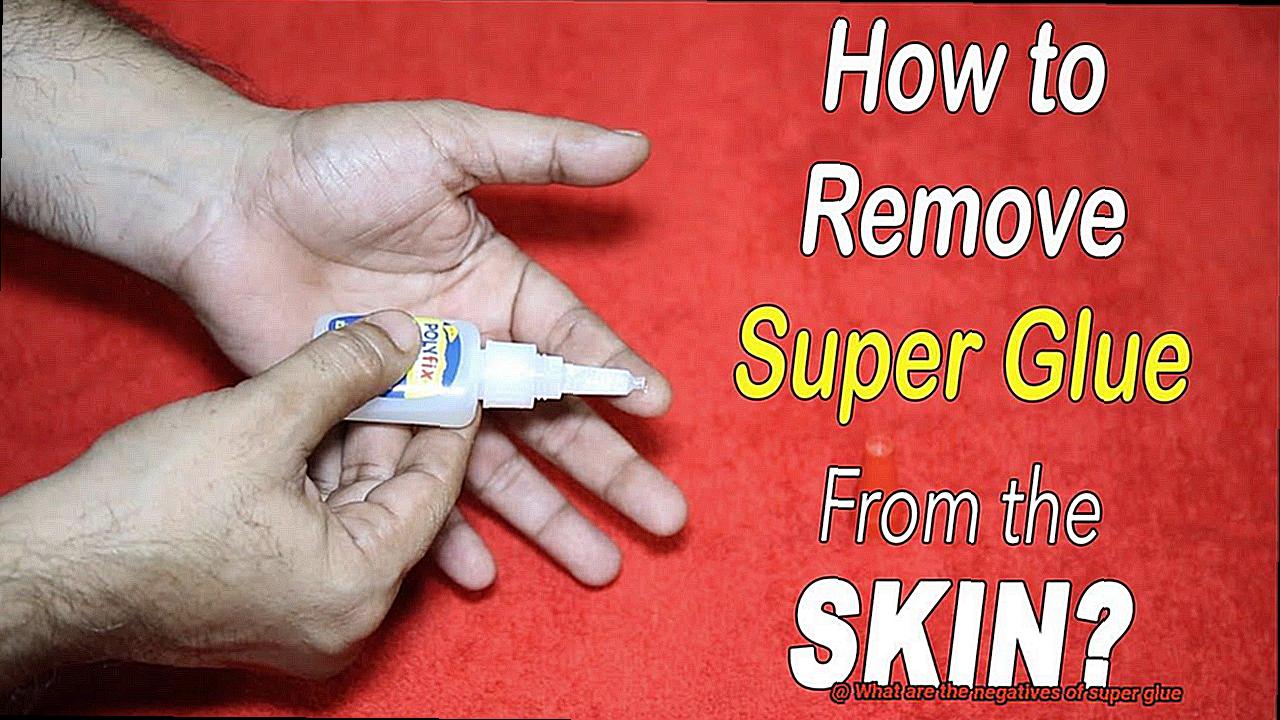
Fixing a broken part in your car engine? Think twice before reaching for the super glue. The scorching heat generated by the engine can cause the adhesive to soften or fail entirely. This can lead to potential safety hazards or damage to your beloved vehicle.
Industrial Settings:
Machinery or equipment in industrial settings often operate at elevated temperatures. Super glue simply can’t handle the heat and won’t provide the durability and reliability needed for long-term bonding. Imagine relying on a weak bond in a critical industrial application – not a good idea.
But fear not. There are specialized adhesives out there designed specifically for high-temperature applications. These superheroes of the adhesive world have unique formulations that allow them to withstand extreme heat without breaking a sweat.
Here are some heat-resistant wonders:
Epoxy Glues:
Known for their exceptional strength and resistance to heat, epoxy glues are perfect for high-temperature bonding needs. They can withstand temperatures up to 500 degrees Fahrenheit, making them a go-to choice for automotive and industrial applications.
Silicone-Based Adhesives:
Silicone-based adhesives offer excellent resistance to high temperatures and provide flexibility in bonding materials that experience thermal expansion or contraction. They are commonly used in electrical and electronic applications.
Polyurethane Adhesives:
Polyurethane adhesives are known for their versatility and ability to maintain bond strength even in high-temperature environments. They can withstand temperatures up to 250 degrees Fahrenheit and are commonly used in construction, automotive, and aerospace industries.
VlXPOMGFrWI” >
Also Read: Is Gorilla Super Glue Waterproof?
Conclusion
Super glue, despite its many benefits, does come with a few drawbacks.
Firstly, its strong adhesive properties can be both a blessing and a curse. While it’s great for holding things together, it can also make accidental spills or mistakes difficult to fix.
Secondly, super glue is not very forgiving when it comes to repositioning or removing items that have been glued together. Once it sets, it’s nearly impossible to undo the bond without causing damage.
Additionally, the fumes emitted by super glue can be quite potent and irritating to the eyes and respiratory system. It’s essential to use this adhesive in a well-ventilated area to avoid any health issues.
This means you may end up wasting unused portions of the adhesive if you don’t use it frequently enough.



